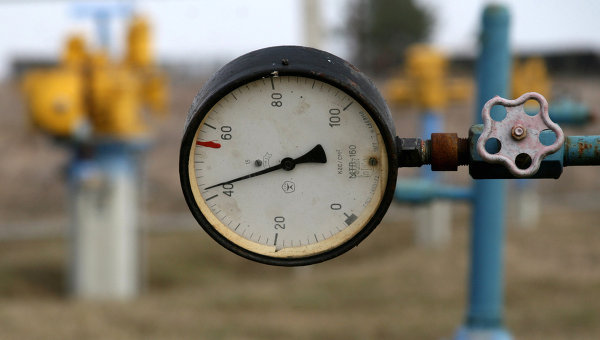
Ukraine Importing Gas from Germany via Hungary and Poland
Publication: Eurasia Daily Monitor Volume: 10 Issue: 60
By:

Denting Russian Gazprom’s monopoly, Ukraine is procuring small but growing volumes of natural gas from Europe. The German Rheinisch-Westfaelisches Elektrizitaetswerk (RWE) is providing the volumes through its subsidiary, RWE Supply & Trading. Ukraine’s neighbors Hungary and Poland are providing the transit services. The three countries have recently made technical arrangements to use their pipelines in the reverse mode for pumping these limited volumes.
On March 28, Ukraine began importing natural gas from RWE through Hungarian pipelines. Prime Ministers Viktor Orban and Mykola Azarov announced the start of gas transmission via Hungary, effective that day, at their March 28 joint news conference in Budapest (MTI, Magyar Hirlap, Interfax-Ukraine, March 28, 29).
According to Azarov, “The Hungarian government experienced considerable pressure, but it took a good-neighborly stand” in authorizing the gas deliveries to Ukraine. He stopped short of specifying where such pressure had come from (Ukrinform, March 29).
Hungarian FGSZ (Foeldgazszallitasrol [Natural Gas Transmission], independent transmission operator unbundled from MOL) is handling these gas shipments under a technical agreement with its counterpart Ukrtranshaz (Naftohaz Ukrainy’s gas transmission subsidiary).
According to Naftohaz officials, the transmission capacity from Hungary to Ukraine currently stands at 3 million cubic meters (mcm) per day, and is scheduled to increase to 15 mcm per day in the second quarter of 2013. In annualized terms, this would translate into an increase from 1.1 billion cubic meters (bcm) to some 5.5 bcm. Ukrainian Energy Minister Eduard Stavytsky says that Naftohaz is purchasing gas from RWE at the spot market price of $380 per one thousand cubic meters at this time. This is significantly below Gazprom’s sale price of $406 per one thousand cubic meters of gas to Ukraine in the first quarter of 2013 (Ukrinform, March 28; Interfax-Ukraine, March 28, 29).
Ukraine had never procured natural gas from Europe until November 2012, when it started importing gas from RWE through a Polish pipeline adapted for bi-directional use (see EDM, November 20, 2012). Ukrtranshaz signed a transportation agreement with Poland’s pipeline operator Gaz-System in August 2012; and Naftohaz signed a sale-and-purchase contract with RWE in October 2012, with trial-run deliveries starting on November 1, cumulatively amounting to approximately 50 mcm by January 1, 2013. Deliveries reached an average daily rate of 2 mcm in the first quarter of 2013 and are planned to rise to 5 mcm per day in the second quarter. In annualized terms this would translate into an increase from some 700 mcm to 1.8 bcm. The price was $417 dollars per one thousand cubic meters in November–December 2012, but dropped to $390 in January 2013, while Gazprom was charging $409. RWE’s price dropped again to an average of $380 per one thousand cubic meters, compared with Gazprom’s average sale price of $406 to Ukraine in the first quarter of 2013. Ukrainian officials anticipate that Poland would complete this pipeline’s upgrade before the end of 2013, enabling an annual flow of 2 bcm to Ukraine in 2014 (Interfax-Ukraine, February 22, March 21, 28; Ukrinform, November 1, 2012, and March 28, 29, 2013).
Slovakia’s transit pipeline operator, Eustream, is also negotiating with Ukrtranshaz for possible transmission of gas supplies from RWE to Ukraine. Like Ukraine, Slovakia is also concerned about the under-utilization of its transit system, as Russia shifts export volumes into other corridors or threatens to do so (North Stream, South Stream). Given Eustream’s transit capacity of more than 90 bcm per year through its four parallel lines, Ukraine sees in Slovakia the biggest opportunity for arranging reverse-flows. Ukrainian officials allude to an immediate reverse-flow possibility for 2 bcm per year, with a potential for 10 bcm per year, if one of the four parallel lines is used for transmission in reverse. This might necessitate construction of a new, bi-directional interconnection near the Velke Kapusany compressor station, complete with gas metering, on the Slovak side of the common border. Bilateral talks ongoing since mid-2012 have not borne fruit thus far. The European Commission’s spokeswoman Marlene Holzner has indicated that the Commission is willing to facilitate an interconnection agreement (Interfax-Ukraine, January 21, March 28, 29; Ukrinform, March 11, 29).
Ukrtranshaz is discussing also with Romania’s network operator, Transgaz, the possibility of arranging reverse-flow transmission to Ukraine. A memorandum of intent has been signed regarding possible use of metering stations at Tekove (Carpathian oblast) or Orlivka (Odessa oblast), both located on the Ukrainian side of the Ukrainian-Romanian border. The reverse-transmission capacity at Tekove is cited as 5 mcm per day, implying 1.8 bcm if annualized (Interfax-Ukraine, Ukrinform, March 29). The supply source, however, has not been publicly identified, nor is it readily apparent. Hypothetically, it could be a correspondingly small volume from Nabucco-West, in view of Ukraine’s declared interest in accessing Azerbaijani gas from the Trans-Anatolia Pipeline.




